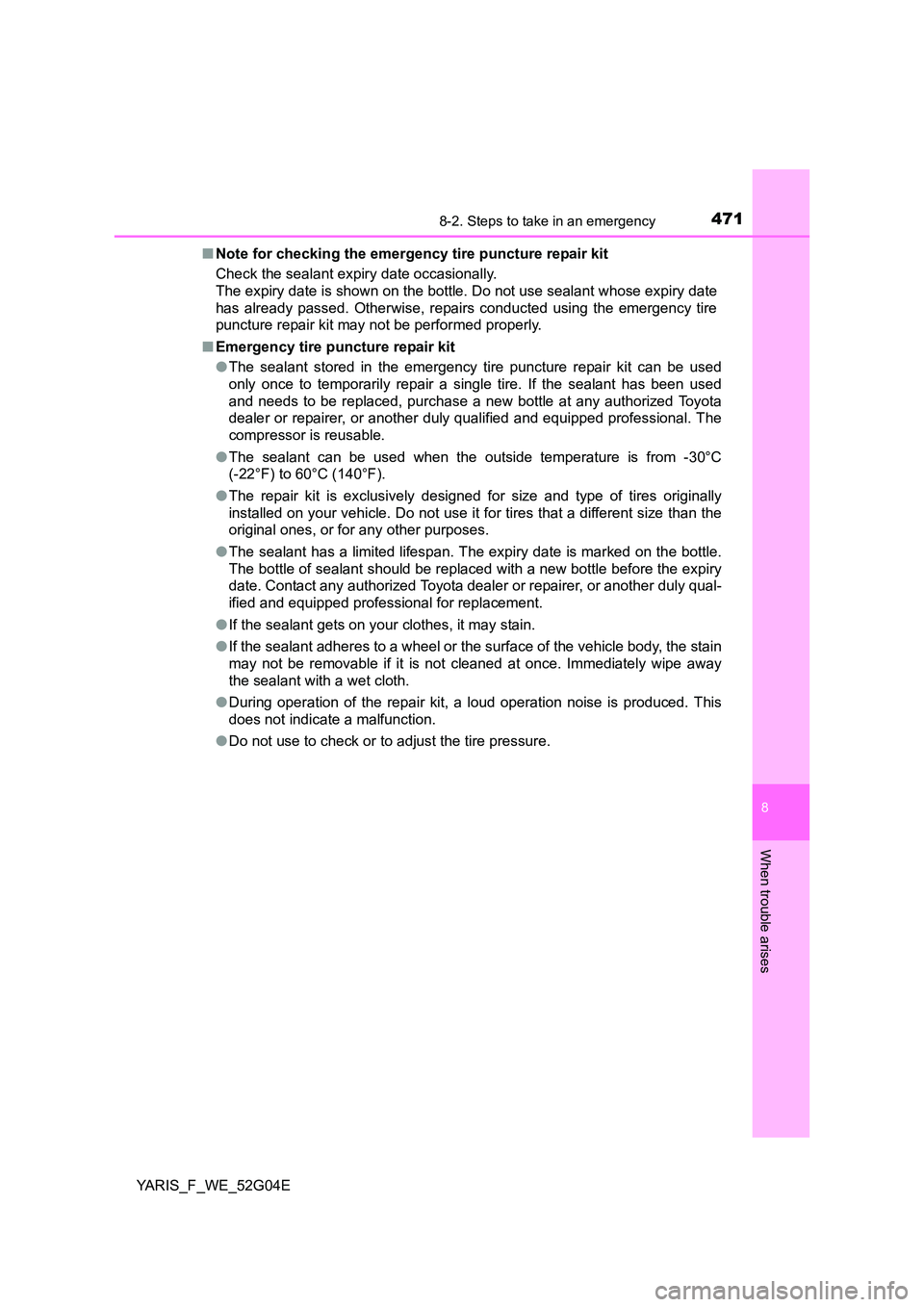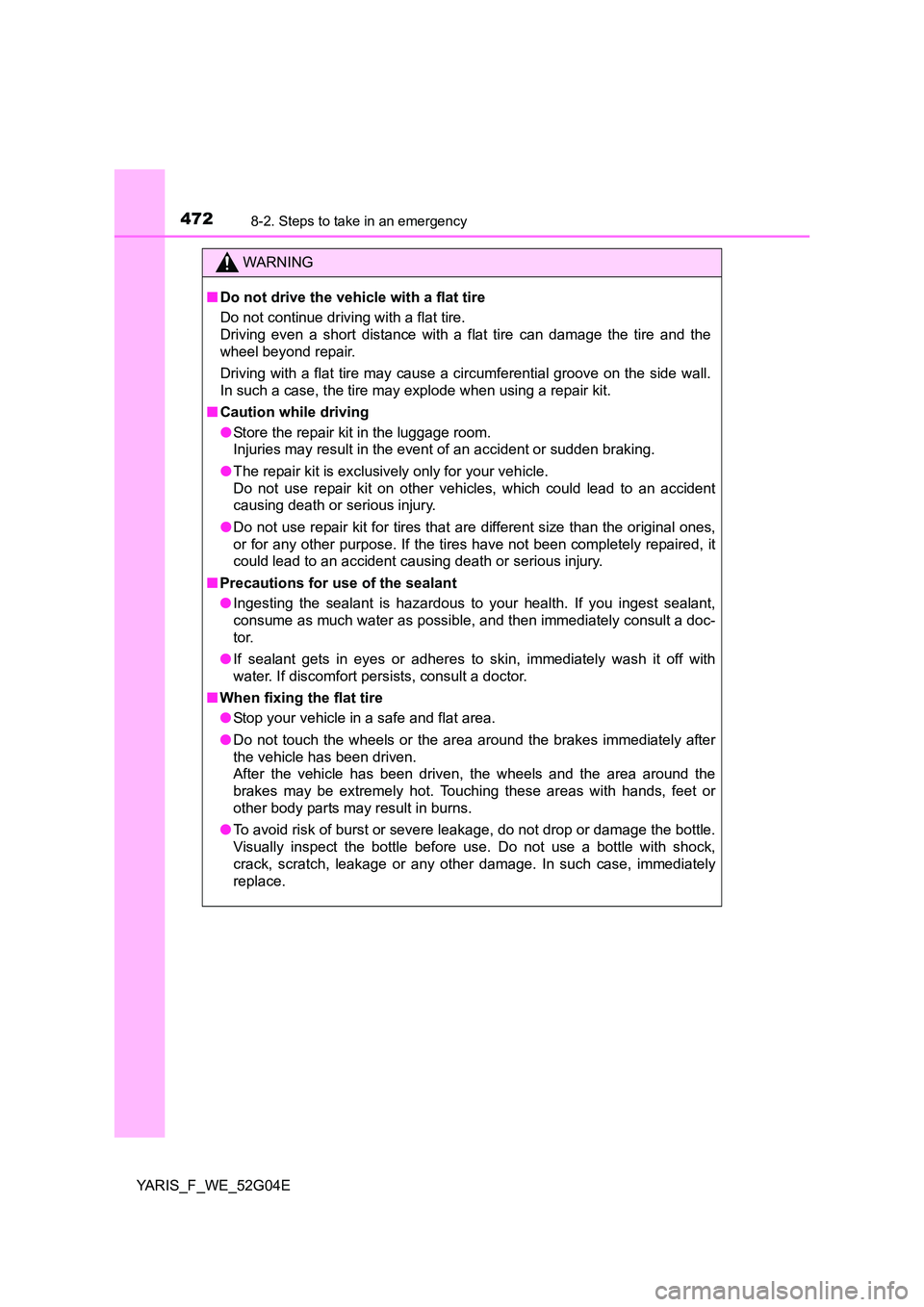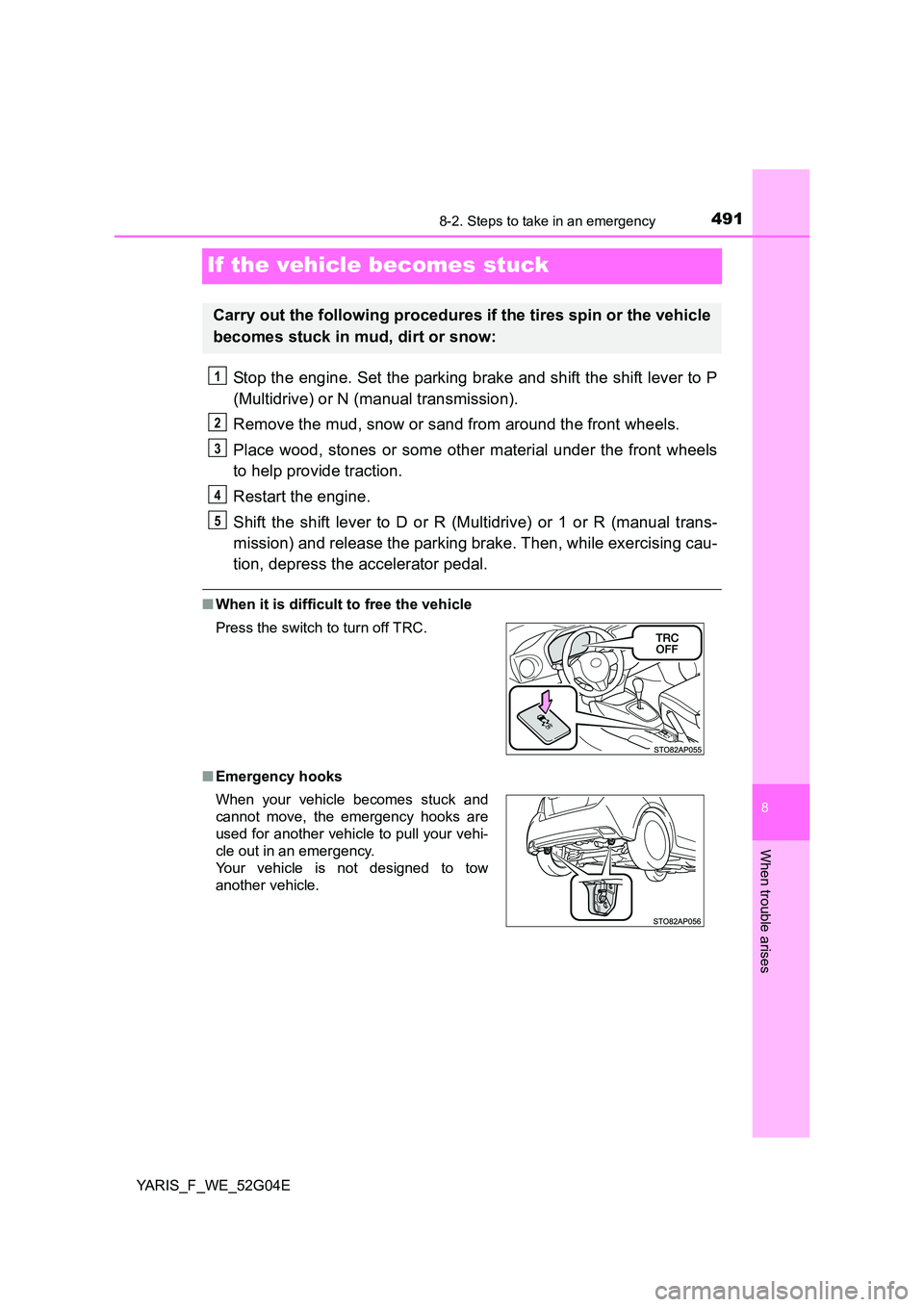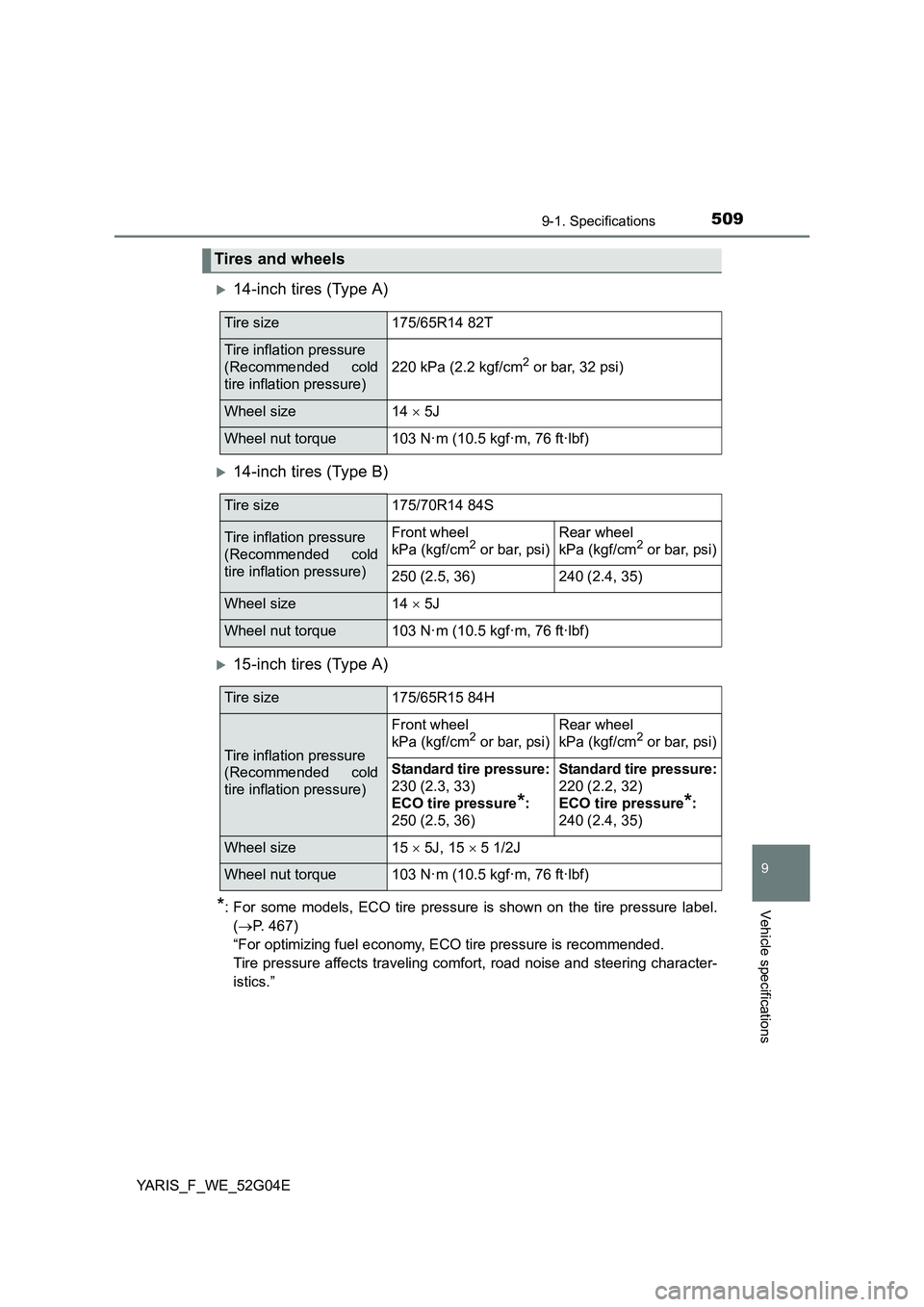tires TOYOTA YARIS HATCHBACK 2015 Owner's Guide
[x] Cancel search | Manufacturer: TOYOTA, Model Year: 2015, Model line: YARIS HATCHBACK, Model: TOYOTA YARIS HATCHBACK 2015Pages: 540, PDF Size: 34.12 MB
Page 450 of 540

4508-2. Steps to take in an emergency
YARIS_F_WE_52G04E
Chock the tires.
For vehicles with steel wheels,
remove the wheel ornament
using the wrench.
To protect the wheel ornament,
place a rag between the wrench
and the wheel ornament.
Slightly loosen the wheel nuts
(one turn).
Replacing a flat tire
1
Flat tireWheel chock positions
FrontLeft-hand sideBehind the rear right-hand side tire
Right-hand sideBehind the rear left-hand side tire
RearLeft-hand sideIn front of the front right-hand side tire
Right-hand sideIn front of the front left-hand side tire
2
3
Page 455 of 540

4558-2. Steps to take in an emergency
8
When trouble arises
YARIS_F_WE_52G04E
■The compact spare tire
● The compact spare tire is identified by the label “TEMPORARY USE ONLY”
on the tire sidewall.
Use the compact spare tire temporarily, and only in an emergency.
● Make sure to check the tire inflation pressure of the compact spare tire.
( P. 509)
■ After completing the tire change (vehicles with a tire pressure warning
system)
The tire pressure warning system must be reset. ( P. 375)
■ When using the spare tire (include compact spare tire) (vehicles with a
tire pressure warning system)
As the spare tire is not equipped with a tire pressure warning valve and trans-
mitter, low inflation pressure of the spare tire will not be indicated by the tire
pressure warning system. Also, if you r eplace a flat tire with the spare tire
after the tire pressure warning light comes on, the light remains on.
■ If you have a flat front tire on a road covered with snow or ice
Install the compact spare tire on one of the rear wheels of the vehicle. Per-
form the following steps and fit tire chains to the front tires:
Replace a rear tire with the compact spare tire.
Replace the flat front tire with the tire removed from the rear of the vehi-
cle.
Fit tire chains to the front tires.
1
2
3
Page 459 of 540

4598-2. Steps to take in an emergency
8
When trouble arises
YARIS_F_WE_52G04E
NOTICE
■Do not drive the vehicle with a flat tire
Do not continue driving with a flat tire.
Driving even a short distance with a flat tire can damage the tire and the
wheel beyond repair.
■ Be careful when driving over bumps with the compact spare tire
installed on the vehicle
The vehicle becomes lower when driving with the compact spare tire com-
pared to when driving with standard tires. Be careful when driving over
uneven road surfaces.
■ Driving with tire chains and the compact spare tire
Do not fit tire chains to the compact spare tire.
Tire chains may damage the vehicle body and adversely affect driving per-
formance.
■ When replacing the tires (vehicles with a tire pressure warning system)
When removing or fitting the wheels, tire s or the tire pressure warning valve
and transmitter, contact any authorized Toyota dealer or repairer, or another
duly qualified and equipped professional as the tire pressure warning valve
and transmitter may be damaged if not handled correctly.
Page 463 of 540

4638-2. Steps to take in an emergency
8
When trouble arises
YARIS_F_WE_52G04E
Check the degree of the tire dam-
age.
• Do not remove the nail or screw
from the tire. Removing the object
may widen the opening and pre-
vent emergency repair with the
repair kit.
• To avoid sealant leakage, move
the vehicle until the area of the
puncture, if known, is positioned at
the top of the tire.
■ In the following cases, the tire cannot be repaired with the emergency
tire puncture repair kit. Contact any authorized Toyota dealer or repairer,
or another duly qualified and equipped professional.
● When the tire is damaged due to driving without sufficient air pressure
● When there are any cracks or damage at any location on the tire, such as on
the side wall, except the tread
● When the tire is visibly separated from the wheel
● When the cut or damage to the tread is 4 mm (0.16 in.) long or more
● When the wheel is damaged
● When two or more tires have been punctured
● When more than 2 sharp objects such as nails or screws have passed
through the tread on a single tire
● When the sealant has expired
Before performing emergency repair
Page 471 of 540

4718-2. Steps to take in an emergency
8
When trouble arises
YARIS_F_WE_52G04E
■ Note for checking the emergency tire puncture repair kit
Check the sealant expiry date occasionally.
The expiry date is shown on the bottle. Do not use sealant whose expiry date
has already passed. Otherwise, repairs conducted using the emergency tire
puncture repair kit may not be performed properly.
■ Emergency tire puncture repair kit
● The sealant stored in the emergency tire puncture repair kit can be used
only once to temporarily repair a single tire. If the sealant has been used
and needs to be replaced, purchase a new bottle at any authorized Toyota
dealer or repairer, or another duly qualified and equipped professional. The
compressor is reusable.
● The sealant can be used when the outside temperature is from -30°C
(-22°F) to 60°C (140°F).
● The repair kit is exclusively designed for size and type of tires originally
installed on your vehicle. Do not use it for tires that a different size than the
original ones, or for any other purposes.
● The sealant has a limited lifespan. The expiry date is marked on the bottle.
The bottle of sealant should be replaced with a new bottle before the expiry
date. Contact any authorized Toyota dealer or repairer, or another duly qual-
ified and equipped professional for replacement.
● If the sealant gets on your clothes, it may stain.
● If the sealant adheres to a wheel or the surface of the vehicle body, the stain
may not be removable if it is not cleaned at once. Immediately wipe away
the sealant with a wet cloth.
● During operation of the repair kit, a loud operation noise is produced. This
does not indicate a malfunction.
● Do not use to check or to adjust the tire pressure.
Page 472 of 540

4728-2. Steps to take in an emergency
YARIS_F_WE_52G04E
WARNING
■Do not drive the vehicle with a flat tire
Do not continue driving with a flat tire.
Driving even a short distance with a flat tire can damage the tire and the
wheel beyond repair.
Driving with a flat tire may cause a circumferential groove on the side wall.
In such a case, the tire may explode when using a repair kit.
■ Caution while driving
● Store the repair kit in the luggage room.
Injuries may result in the event of an accident or sudden braking.
● The repair kit is exclusively only for your vehicle.
Do not use repair kit on other vehicles, which could lead to an accident
causing death or serious injury.
● Do not use repair kit for tires that are different size than the original ones,
or for any other purpose. If the tires have not been completely repaired, it
could lead to an accident causing death or serious injury.
■ Precautions for use of the sealant
● Ingesting the sealant is hazardous to your health. If you ingest sealant,
consume as much water as possible, and then immediately consult a doc-
tor.
● If sealant gets in eyes or adheres to skin, immediately wash it off with
water. If discomfort persists, consult a doctor.
■ When fixing the flat tire
● Stop your vehicle in a safe and flat area.
● Do not touch the wheels or the area around the brakes immediately after
the vehicle has been driven.
After the vehicle has been driven, the wheels and the area around the
brakes may be extremely hot. Touching these areas with hands, feet or
other body parts may result in burns.
● To avoid risk of burst or severe leakage, do not drop or damage the bottle.
Visually inspect the bottle before use. Do not use a bottle with shock,
crack, scratch, leakage or any other damage. In such case, immediately
replace.
Page 491 of 540

4918-2. Steps to take in an emergency
8
When trouble arises
YARIS_F_WE_52G04E
If the vehicle becomes stuck
Stop the engine. Set the parking brake and shift the shift lever to P
(Multidrive) or N (manual transmission).
Remove the mud, snow or sand from around the front wheels.
Place wood, stones or some other material under the front wheels
to help provide traction.
Restart the engine.
Shift the shift lever to D or R (Multidrive) or 1 or R (manual trans-
mission) and release the parking brake. Then, while exercising cau-
tion, depress the accelerator pedal.
■ When it is difficult to free the vehicle
■ Emergency hooks
Carry out the following procedures if the tires spin or the vehicle
becomes stuck in mud, dirt or snow:
Press the switch to turn off TRC.
When your vehicle becomes stuck and
cannot move, the emergency hooks are
used for another vehicle to pull your vehi-
cle out in an emergency.
Your vehicle is not designed to tow
another vehicle.
1
2
3
4
5
Page 495 of 540

4959-1. Specifications
9
Vehicle specifications
YARIS_F_WE_52G04E
*1: Unladen vehicles
*2: Vehicles with rough road package (without raised vehicle height)
*3: Vehicles with rough road package (with raised vehicle height)
*4: 175/65R14, 175/70R14 or 175/65R15 tires
*5: 185/60R15 tires
*6: 195/50R16 tires
*7: Vehicle category N1 models
Towing capacity with brake
1KR-FE engine
730 kg (1609 lb.)
1NR-FE engine
880 kg (1940 lb.)
1ND-TV engine
780 kg (1719 lb.)
without brake 550 kg (1212 lb.)
Maximum permissible mass for tow-
ing hitch/bracket*719 kg (41 lb.)
Page 509 of 540

5099-1. Specifications
9
Vehicle specifications
YARIS_F_WE_52G04E
14-inch tires (Type A)
14-inch tires (Type B)
15-inch tires (Type A)
*: For some models, ECO tire pressure is shown on the tire pressure label.
( P. 467)
“For optimizing fuel economy, ECO tire pressure is recommended.
Tire pressure affects traveling comfort, road noise and steering character-
istics.”
Tires and wheels
Tire size175/65R14 82T
Tire inflation pressure
(Recommended cold
tire inflation pressure)
220 kPa (2.2 kgf/cm2 or bar, 32 psi)
Wheel size14 5J
Wheel nut torque103 N·m (10.5 kgf·m, 76 ft·lbf)
Tire size175/70R14 84S
Tire inflation pressure
(Recommended cold
tire inflation pressure)
Front wheel
kPa (kgf/cm2 or bar, psi)
Rear wheel
kPa (kgf/cm2 or bar, psi)
250 (2.5, 36)240 (2.4, 35)
Wheel size14 5J
Wheel nut torque103 N·m (10.5 kgf·m, 76 ft·lbf)
Tire size175/65R15 84H
Tire inflation pressure
(Recommended cold
tire inflation pressure)
Front wheel
kPa (kgf/cm2 or bar, psi)
Rear wheel
kPa (kgf/cm2 or bar, psi)
Standard tire pressure:
230 (2.3, 33)
ECO tire pressure*:
250 (2.5, 36)
Standard tire pressure:
220 (2.2, 32)
ECO tire pressure*:
240 (2.4, 35)
Wheel size15 5J, 15 5 1/2J
Wheel nut torque103 N·m (10.5 kgf·m, 76 ft·lbf)
Page 510 of 540

5109-1. Specifications
YARIS_F_WE_52G04E
15-inch tires (Type B)
16-inch tires
Tire size185/60R15 84H
Tire inflation pressure
(Recommended cold
tire inflation pressure)
Vehicle speed
Front wheel
kPa (kgf/cm2
or bar, psi)
Rear wheel
kPa (kgf/cm2 or
bar, psi)
160 km/h
(99 mph) or
less
220 (2.2, 32)220 (2.2, 32)
More than
160 km/h
(99 mph)
240 (2.4, 35)220 (2.2, 32)
Wheel size15 5 1/2J
Wheel nut torque103 N·m (10.5 kgf·m, 76 ft·lbf)
Tire size195/50R16 84V
Tire inflation pressure
(Recommended cold
tire inflation pressure)
Vehicle speed
Front wheel
kPa (kgf/cm2
or bar, psi)
Rear wheel
kPa (kgf/cm2 or
bar, psi)
160 km/h
(99 mph) or
less
220 (2.2, 32)200 (2.0, 29)
More than
160 km/h
(99 mph)
240 (2.4, 35)210 (2.1, 30)
Wheel size16 6J
Wheel nut torque103 N·m (10.5 kgf·m, 76 ft·lbf)